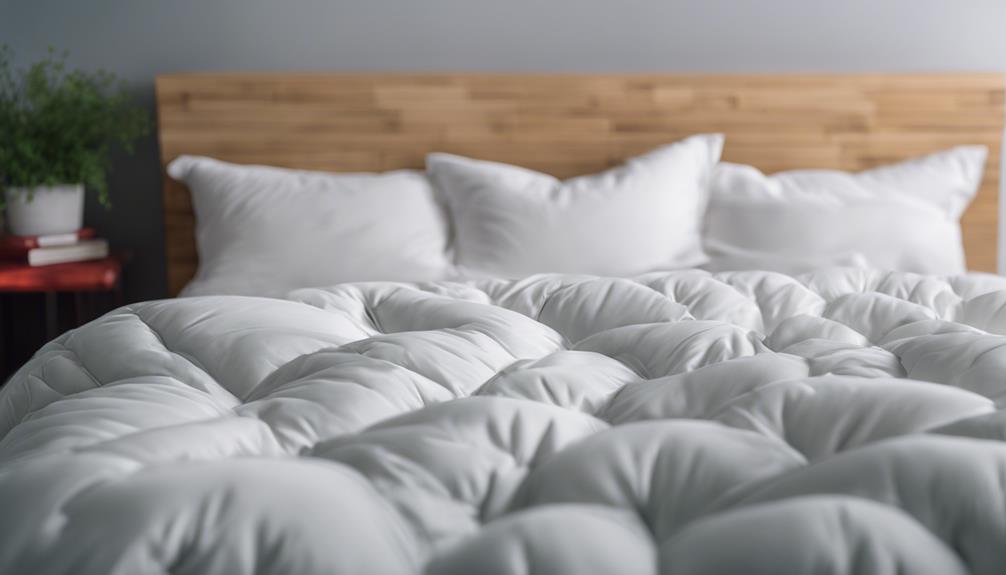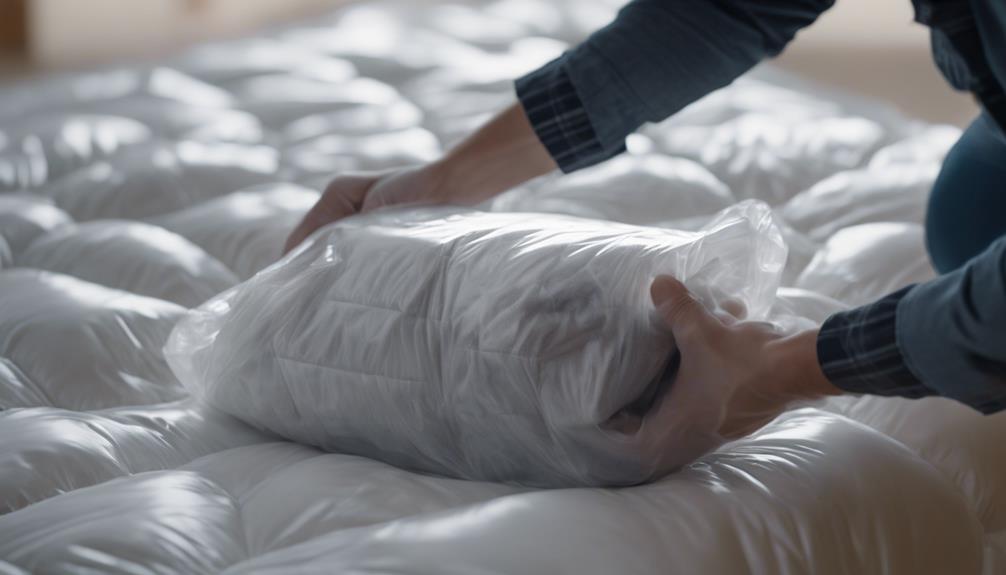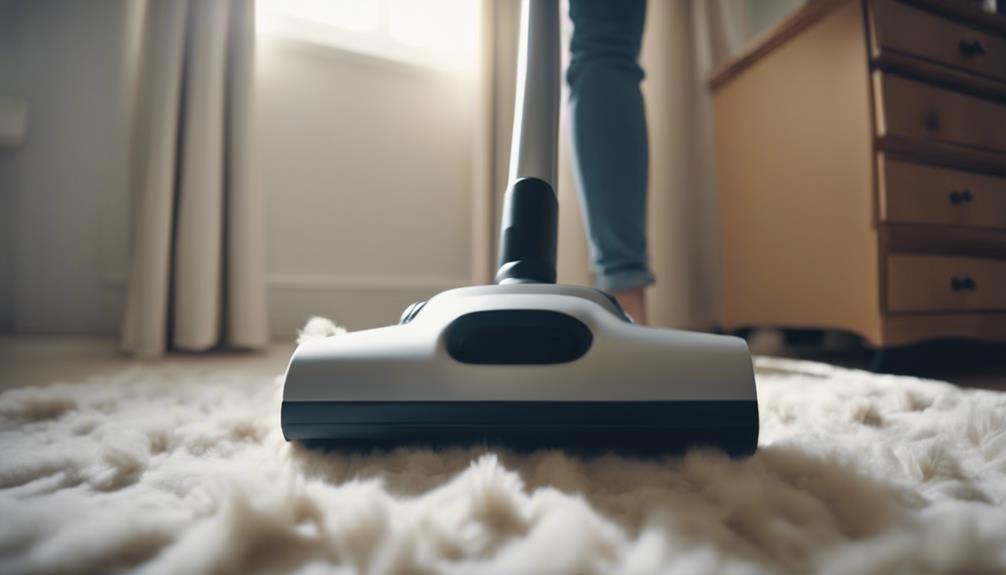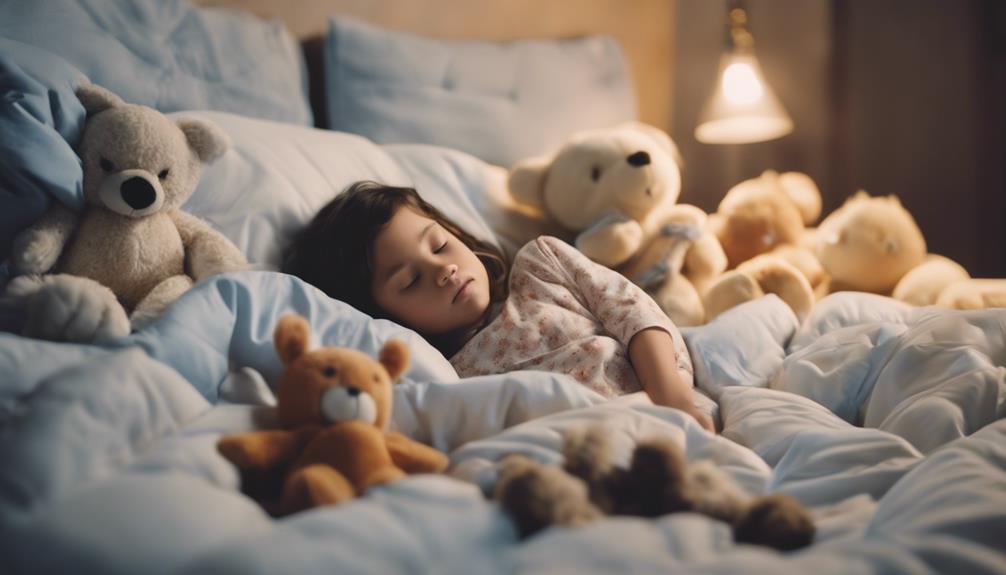Allergic reactions to a down comforter can be caused by dust mites and dust, not the down itself. This can result in symptoms such as a runny nose, coughing, congestion, and a sore throat. In rare instances, severe reactions may include facial swelling, airway closure, and hives. Choosing hypoallergenic bedding or down alternative comforters could be beneficial. If symptoms persist, it is imperative to seek advice from a healthcare provider for accurate diagnosis and treatment. Increasing awareness about feather allergens and prevention strategies can help in effectively managing these allergies.
Key Takeaways
- Allergic reactions to down comforters are often due to dust mites and dust, not the down itself.
- Feather allergies can cause symptoms like runny nose, coughing, and congestion.
- Severe cases may lead to facial swelling, airway closure, and hives.
- Opt for hypoallergenic bedding or down alternative comforters for relief.
- Consult a healthcare professional for proper diagnosis and treatment options.
Allergic Reactions to Down Comforters
When we encounter allergic reactions to down comforters, they're often mistakenly attributed to dust mites and dust rather than the down itself. While feather allergies are uncommon, they can still cause discomfort for some individuals.
True allergies to goose down feathers are rare, especially among those who already have sensitivities to dust and dander. Symptoms of feather allergy can manifest as a runny nose, coughing, congestion, and a sore throat. In more severe cases, allergic reactions to down comforters may lead to facial swelling, airway closure, and hives.
It's important to differentiate between reactions to the down itself and other allergens that may be present in bedding. Opting for hypoallergenic bedding or down alternative comforters can be an effective solution for those experiencing allergic responses to down comforters.
Symptoms of Down Comforter Allergies

When experiencing down comforter allergies, common symptoms like runny nose, coughing, congestion, and sore throat may arise. Opting for hypoallergenic bedding or down alternative comforters can help alleviate these discomforts.
If severe symptoms persist, seeking medical advice is essential for proper management.
Common Allergy Symptoms
Experiencing common allergy symptoms such as a runny nose, coughing, congestion, and a sore throat can indicate an allergic reaction to a down comforter. When feather bedding contains dust mites or feathers, it can trigger these reactions.
The symptoms of feather and dust mite allergies often overlap, making it challenging to differentiate between the two. Allergies to goose down can persist over time and prove difficult to fully eliminate.
To manage down comforter allergies, hypoallergenic bedding or medications like antihistamines are recommended. These options can help alleviate the symptoms and provide relief from the discomfort caused by allergic reactions to feather bedding.
Handling Down Alternatives
One effective way to manage symptoms of down comforter allergies is by considering down alternative comforters made of hypoallergenic polyester. These alternatives are designed to be suitable for individuals with allergies to real down feathers.
While they may not offer the exact plushness of genuine goose down comforters, down alternative duvets still provide a similar level of comfort. Additionally, they're a more budget-friendly option compared to real down comforters.
Reading reviews on platforms like Amazon can help you choose a high-quality down alternative duvet based on user experiences. Opting for down alternative comforters can help individuals with allergies avoid potential reactions to real goose down feathers, providing a comfortable and allergy-free sleep experience.
Seeking Medical Advice
What're the common symptoms of down comforter allergies that individuals should be aware of?
Allergic reactions to down comforters can manifest as red, watery eyes, coughing, congestion, and skin irritation. These symptoms may resemble hay fever, leading to fatigue and swelling upon waking.
While true allergies to down comforters are rare, reactions to dust mites and dander are more common. In severe cases, allergic reactions to down comforters can result in facial swelling, airway closure, and hives.
If experiencing severe allergic reactions to down comforters, seeking medical advice is essential for proper diagnosis and treatment. It's important to consult a healthcare professional to manage and alleviate these symptoms effectively.
Causes of Down Comforter Allergies

When considering the causes of down comforter allergies, it's crucial to understand that the primary culprits are often dust mites and mold rather than the feathers themselves. Dust mites, microscopic creatures that thrive in warm and humid environments, can trigger allergic reactions in some individuals. These tiny pests feed on dead skin cells and can be found in bedding, including down comforters.
Symptoms like a runny nose, coughing, and congestion are more likely due to dust mites present in the bedding rather than a direct allergic reaction to the feathers. It's worth mentioning that true allergies to goose down feathers are rare, with feather bedding often triggering dust mite-related reactions.
To minimize allergic reactions, opting for hypoallergenic bedding or regularly cleaning your down comforter can be beneficial. Understanding these common causes can help individuals manage their allergies and enjoy a comfortable night's sleep.
Down Comforters Vs. Hypoallergenic Options

In comparing down comforters to hypoallergenic options, it becomes evident that selecting the right bedding is essential for managing allergies effectively.
- Down Alternative Comforters: Made of synthetic materials like polyester, these are a hypoallergenic choice for those concerned about allergies to down comforters.
- Barrier Fabrics: Hypoallergenic comforters often feature barrier fabrics that help keep allergens out, providing a protective layer against potential irritants.
- Hyperclean Technology: Companies like Pacific Coast use advanced technologies to guarantee cleanliness in their down comforters, reducing the risk of allergen exposure.
- Reviews and Recommendations: Platforms like Amazon offer valuable reviews that can assist in selecting a suitable down alternative duvet, providing insights from other users on comfort, quality, and allergy management.
Managing Down Comforter Allergy Symptoms

To effectively manage down comforter allergy symptoms, individuals should consider using hypoallergenic bedding or taking antihistamines as recommended by healthcare professionals. Allergy sufferers experiencing symptoms like runny nose, coughing, congestion, and sore throat due to down comforters can benefit from these strategies.
Hypoallergenic bedding helps reduce exposure to dust mites and feathers that can trigger allergic reactions. These specially designed covers and comforters create a barrier against common allergens present in traditional bedding. Antihistamines can also provide relief by blocking histamine release in the body, alleviating symptoms such as sneezing and itching.
It's important for allergy sufferers to consult with their healthcare providers before starting any new medication to make sure proper dosage and safety. By proactively managing down comforter allergy symptoms through these methods, individuals can minimize discomfort and improve their quality of sleep.
Seeking Medical Advice for Allergies

If you suspect an allergy to your down comforter, it's important to consult an allergist for advice. They can help identify the specific allergens causing your symptoms and offer treatment options.
Seeking medical advice is vital in managing down comforter allergies effectively.
Consult Allergist for Advice
Seeking professional advice from an allergist is essential for effectively managing allergies to a down comforter. Allergists play a vital role in diagnosing and treating allergies, providing personalized recommendations to help you cope with your symptoms. Here are some key reasons why consulting an allergist is beneficial:
- Accurate Diagnosis: Allergists can conduct tests to pinpoint the specific allergens, such as feather proteins, triggering your reactions to down bedding.
- Customized Treatment: Based on your diagnosis, allergists can recommend suitable treatments like antihistamines or hypoallergenic bedding to alleviate allergic symptoms.
- Management Plan: Seeking medical advice is crucial for developing a tailored management plan to address your specific allergy needs.
- Quality of Life Improvement: A consultation with an allergist can offer personalized guidance on avoiding triggers and enhancing your overall quality of life.
Identify Specific Allergens
Identifying specific allergens is essential when seeking medical advice for managing allergies to a down comforter. Allergy testing can pinpoint the exact triggers causing reactions, which may not necessarily be the feathers themselves.
Symptoms like runny noses and itchy eyes are often linked to dust mites or dust rather than the down. While true allergies to goose feathers are rare, dust mites and dander are more common culprits.
If you find yourself experiencing persistent allergic reactions to down comforters, it's advisable to consult a healthcare professional for guidance. They can recommend strategies such as using hypoallergenic bedding or taking medications like antihistamines to help alleviate your symptoms effectively.
Explore Treatment Options
Exploring treatment options for allergies to down comforters involves consulting with an allergy specialist to pinpoint the specific allergen triggering symptoms. Once the allergen is identified, various treatment options can be considered to manage the allergic reactions effectively.
Here are some sustainable products that promote allergy relief:
- Hypoallergenic bedding: Opt for hypoallergenic down comforters or alternative bedding materials to reduce allergen exposure.
- Air purifiers: Use air purifiers with HEPA filters to remove allergens from the air in your bedroom.
- Regular cleaning: Wash bedding in hot water weekly and vacuum frequently to minimize allergen buildup.
- Allergy medications: Over-the-counter or prescription allergy medications can help alleviate symptoms when exposure to allergens is unavoidable.
Prevention Tips for Down Comforter Allergies

To prevent allergies caused by down comforters, using hypoallergenic options is highly recommended. Hypoallergenic down comforters are designed to reduce the risk of allergic reactions.
Regularly washing and drying down comforters on high heat can help eliminate dust mites, another common allergen. If you find yourself allergic to real down feathers, consider switching to down alternative comforters.
Investing in dust mite-proof covers for your down comforter can also provide an extra layer of protection against allergens. If you experience severe allergic reactions to down comforters despite these preventive measures, it's essential to seek medical advice for further guidance.
Understanding Feather Allergens

Feather allergies, though rare, can cause symptoms resembling hay fever, leading to fatigue and swelling. When it comes to understanding feather allergens, it's essential to note the specific factors that contribute to these reactions:
- Goose Feathers: Goose feathers, commonly used in down comforters, can trigger allergic responses in some individuals due to the proteins present in the feathers.
- Dust Mites and Dander: While feathers themselves aren't top allergens, they can accumulate dust mites and dander if the bedding isn't cleaned regularly. These allergens can exacerbate symptoms in sensitive individuals.
- Proper Cleaning: Regular cleaning and maintenance of bedding, including down comforters, can help reduce the risk of allergic reactions associated with goose feathers by eliminating dust mites and dander.
- Allergic Reactions: Despite the potential for allergens to accumulate in down comforters, they don't typically cause significant allergic reactions in most people when properly cared for and cleaned.
Are Down Alternative Comforters Safer?

Down alternative comforters are a safer option for those allergic to down feathers, as they're made of hypoallergenic polyester. These comforters aren't only budget-friendly but also provide a comfortable bedding choice without the risk of allergic reactions.
Reviews on platforms like Amazon can help in selecting a high-quality down alternative duvet that meets individual needs.
Down Vs Alternative
When considering bedding options, individuals concerned about allergies may find that down alternative comforters offer a safer and hypoallergenic choice. Here are some reasons why down alternative comforters can be a great option:
- Hypoallergenic: Down alternative comforters, made of materials like polyester, are less likely to trigger allergic reactions compared to real down.
- Cost-effective: They're usually more affordable than authentic down comforters, making them accessible to a wider range of consumers.
- Comfortable: While not as plush as real down, down alternative fillings still provide a comfortable sleeping experience.
- Quality selection: Reviews on platforms like Amazon can guide individuals in choosing a high-quality down alternative comforter that suits their needs.
Allergies and Comforters
Considering the concerns surrounding allergies, exploring the safety of down alternative comforters emerges as an essential aspect in selecting bedding options.
Down alternative comforters, typically made of polyester, are hypoallergenic and suitable for individuals avoiding real down feathers. While these comforters may lack the exact plushness of real down, they offer a more affordable and safer choice for allergy sufferers. Opting for a down alternative comforter can help alleviate symptoms for those allergic to down feathers.
Reviews on platforms like Amazon can assist in selecting a high-quality down alternative duvet that meets individual needs and preferences.
Tips for Allergy-Free Bedding Choices

To minimize allergic reactions to bedding, we recommend selecting hypoallergenic materials such as wool and organic cotton for a healthier sleep environment. When choosing bedding, consider the following tips:
- Organic Cotton Bedding: Opt for organic cotton bedding to avoid harmful chemicals and promote airflow, creating a comfortable sleep environment free from allergens.
- Down Alternative Comforters: Consider down alternative comforters made of polyester for a hypoallergenic option similar to real down, without the risk of triggering allergies.
- Regular Cleaning: Wash and dry bedding regularly on high heat to eliminate dust mites and allergens in down comforters, ensuring a clean sleeping environment.
- Barrier Fabrics: Look for comforters with barrier fabrics that keep allergens out, providing an extra layer of protection against potential allergic reactions.
Frequently Asked Questions
How Do I Know if I'm Allergic to My Down Comforter?
If you're wondering if you're allergic to your down comforter, keep an eye out for symptoms like sneezing, coughing, or congestion. These signs could indicate an allergy.
Since reactions to down can be similar to dust mite allergies, it's tricky to pinpoint the exact cause. If you suspect an allergy, consider switching to hypoallergenic bedding or down alternatives for a safer sleep.
How Do I Know if I'm Allergic to My Bedding?
If you're wondering how to determine if you're allergic to your bedding, keep an eye out for symptoms like red, watery eyes, a stuffy nose, coughing, or congestion. These signs could indicate a reaction to allergens like dust mites, mold, or dander commonly found in bedding.
Seeking medical advice and allergy testing can help pinpoint the specific allergen triggering your reactions, leading to better management of your allergies and overall comfort.
Do Down Comforters Have Dust Mites?
Yes, down comforters can indeed harbor dust mites, pesky allergens that thrive in warm, humid bedding environments. Washing and drying down comforters on high heat can help eliminate these allergens. Symptoms of dust mite allergies include sneezing, coughing, and watery eyes.
Opting for hypoallergenic bedding materials like wool can reduce dust mite presence in comforters. Regular maintenance is key in minimizing allergic reactions to down comforters.
Is a Down Comforter Hypoallergenic?
Yes, a down comforter can be hypoallergenic if properly maintained and cleaned.
Some down comforters undergo hyperclean technology to remove allergens, while barrier fabrics can prevent allergens from penetrating.
Hypoallergenic down comforters are designed to reduce the risk of allergic reactions, making them a suitable choice for sensitive individuals.
Opting for a high-quality down comforter can minimize allergy triggers and provide a comfortable sleeping experience for those prone to allergies.
Can Down Comforters Cause Allergic Reactions in Some People?
Many people with allergies wonder if down comforters can trigger allergic reactions. While some people are sensitive to the proteins in down feathers, others may react to the dust mites that can live in down comforters. Regular cleaning and using a duvet cover can help minimize the risk of down comforters and allergies.
Conclusion
To summarize, while some individuals may experience allergic reactions to down comforters due to feather allergens, there are hypoallergenic options available to help manage symptoms. Understanding the causes and symptoms of down comforter allergies can assist in making informed bedding choices.
Whether opting for a down alternative comforter or taking preventative measures, it's possible to enjoy a cozy and allergy-free sleep environment. Make smart bedding choices to guarantee a comfortable and healthy night's rest.









